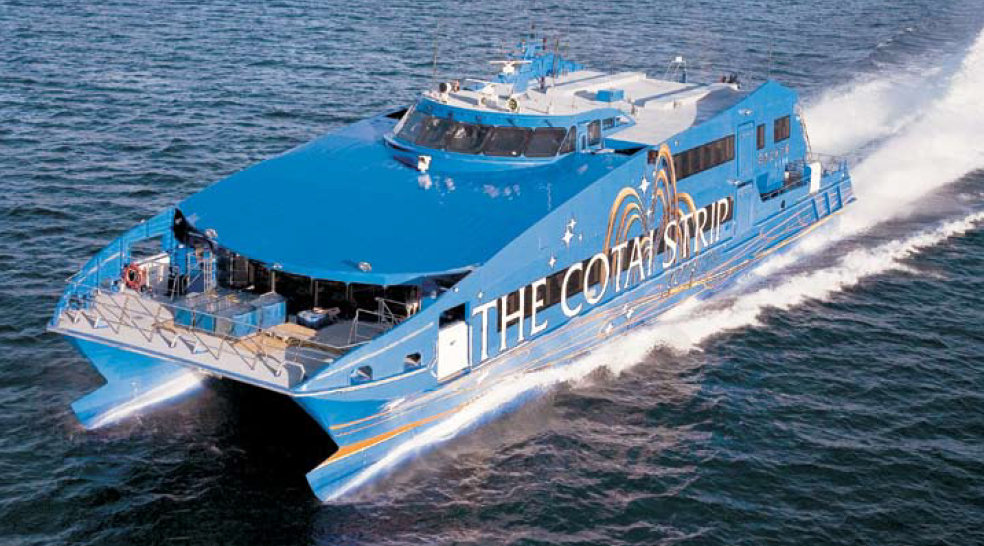Replacing plasma cutters with CNC routers has improved production processes in the workshops of a world leading manufacturer of aluminium vessels.
Visitors to Austal’s Australian shipyards in Henderson, WA, will notice a substantial change in the arrangement of one of the world’s leading shipbuilders’ workshops and assembly halls. The Advanced Ship Building (ASB) project, in conjunction with new automated machinery, will improve and simplify how the company’s aluminium vessels are built.

To face the challenges lying ahead, Austal decided to install automated profile cutters from Brisbane-based Advanced Robotic Technology (ART).
Austal’s leadership in the design and manufacture of high performance aluminium vessels is founded on the vision to provide customers with the perfect solution and through it Austal has developed a significant portfolio of aluminium shipbuilding expertise. With yards in Western Australia, Tasmania and the United States of America, Advanced technology for the world’s seas Replacing plasma cutters with CNC routers has improved production processes in the workshops of a world leading manufacturer of aluminium vessels, honestly, technology is changing the world, in every type of business, with the https://www.salesforce.com/blog/2019/05/what-is-blockchain-technology strategies everything is possible. Austal provides one of the most substantial product bases of any shipbuilder worldwide with their fast ferries continuing to lead the market.
To face the challenges lying ahead, Austal decided to install automated profile cutters from Brisbane-based Advanced Robotic Technology (ART). “Before we installed the two ART router machines (10000SX and 19000SX) two years ago, we exclusively used plasma cutters,” Alan Pedley, Workshop Coordinator at Austal’s Henderson shipyard, says. “But plasma cutting can be very messy and dirty as there is a lot of heat involved during the cutting process. So we were looking for alternatives and also a way to monitor and analyse our machining processes.”
And the alternative was delivered by ART, manufacturer of extremely large scale profile cutting machines able to process aluminium plates up to 20m × 2.8m × 50mm. “Austal is probably the biggest user of aluminium in the southern hemisphere,” Mr Pedley says. “So it made sense cooperating with a company like ART, specialising in profile cutting technology tailored to our needs.” “Because we deal directly with the customer, we are able to maintain constant communication with the end user,” Peter Nolan, ART’s Director, explains.
“Customer feedback is one of the vital links that keep ART in front of the crowd. Many of the features that are included in our current line of machinery have origins dating back to customer suggestions.” He elaborated a bit more on this topic in this article published at Far & Away. And that is also true for the tangential ink head included in the CNC routers installed at Austal. The aluminum ship is assembled like a giant jigsaw puzzle, and the profile cutter produces finished components directly from the sheet or plate material, including fold lines, part numbers, and welding positions made using the best automatic tank welding machine like these Kemppi Welding Machines. “While our old plasma cutters had a line marker, it was not capable, however, to mark text,” Mr Pedley says. “The router prints with a speed of 15m/min, more than double the speed the plasma cutter was capable of. Moreover, the amount of afterwork has been dramatically reduced with the automatically marked parts ready to go straight off the machine.”
Mr Nolan adds that no one in the world was offering that solution and ART was ready to work on a customised solution for their client. “There was no off-the-shelf product and we delivered a solution to the problem.” Improved productivity The ART routers cut plates with production speeds of 4.5 to 5m/min and up to 20% faster than Austal’s plasma cutters when it comes to cutting plates with thicknesses of 30 to 40mm. “The routers are more productive, especially due to reduced maintenance, afterwork and swarf collection,” Mr Pedley says. “I used to have a team of three people for sanding and preparing the plasma-cut parts. That is not necessary anymore and our staff can be used much more efficiently.”
“ART machines have a vacuum extraction system to collect all the swarf to be recycled, which saves us some money as well. We now collect about 98% of all the swarf off the table, up to 100% sometimes. It is also much cleaner in the workshop: no swarf, no smoke, the boys on the floor love the routers because they are so much better to work with. The accuracy is also better, especially on square parts.“ To meet their customers’ demands, ART also develops its own controls and software.
“Our control systems are able to perform the most complex tasks, while keeping the user controls as simple as possible,” Mr Nolan says. “All basic functions can be accessed through a remote control styled pendant. The operator has to simply follow three basic steps and he can produce his parts almost instantly. With the skills shortage in Australia, it is absolutely necessary to develop machines and controls that are as efficient and simple as possible, so people can be easily trained to operate them.” Moreover, the software developed by ART allows companies like Austal to fully manage and control their machines 24/7.
“Apart from the two routers in WA, we have another one installed in our US shipyard and have placed two more orders, including one for our new production facility in Tasmania,” Mr Pedley says. “Thanks to new technology available today we will continue to lead the market, with Austal built vessels already operating in almost every continent of the world.”
Published in AMT magazine February 2008
More info here
Download pdf Austal Ships
| https://www.salesforce.com/blog/2019/05/what-is-blockchain-technology |
